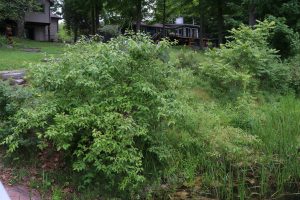by Paige Jessup, Climate Change Resiliency Intern
Each summer, harmful algae blooms are at the forefront of local news around the country. The danger to humans, pets, and livestock have increased public awareness but these blooms also have a profound ecological impact. Could buffer zones play a role in combating these algae blooms?
Toxic algae blooms of most species of cyanobacteria thrive in warm, calm, high nutrient environments. With the increase of global temperatures due to climate change, and persistent use of phosphorus and nitrogen run-off from urban and agricultural activities, we are seeing a steady increase of these toxic blooms. When these blooms overtake an ecosystem, it leads to hypoxic lakes that cannot support life. One solution to prevent this from happening is to look to nature and the benefits of buffer zones.
A buffer zone is a strip of vegetation, ideally 30 metres, around a lake, pond, stream, or river. This vegetation plays a pivotal role in protecting aquatic ecosystems. Not only do they provide habitat for wildlife and shade the water but these buffers also act as filters for sediment, toxins, nutrients, and flood waters (Correll, 2005). Buffer zones, especially ones abundant with native plants that act as anchors for the shoreline, prevent erosion and keep any contaminated soil out of the water (Blankenberg, 2020). Vegetative buffers have many other benefits that enhance soil quality, which often teems with microbes. These microorganisms can degrade or alter pollutants (Cooper, et al., 2014).

Increased intensity of shoreline development leads to a loss of these natural shorelines, allowing more pollutants to enter the water and more sunlight to penetrate it. Moreover, while these areas are vital for keeping pollutants out of the lakes, the excess amount of pollutants are also doing harm to these vegetated areas. An influx in nutrients can cause an excess of plant growth, blocking out sunlight, killing other beneficial plants, and causing the soil to become impoverished of nutrients other than nitrogen and phosphorus (LeSher, n.d.; Smith et al., 1999).
These buffers are not able to support the amount of nutrients that are running off into them. That is why it is important that along with planting native vegetation along the shoreline, we should also be making efforts to reduce run-off by switching to phosphate-free products, avoiding fertilizers on lawns (especially ones that contain phosphate), regularly maintaining septic systems, and following best agricultural practices (Government of Ontario, 2024). Protecting our freshwater sources is important, and it is our collective responsibility to harmonize our actions accordingly.
This blog is part of a larger education toolkit about cyanobacteria. To access all of the resources from the toolkit, visit watersheds.ca/cyanobacteria
References
Blankenberg, AG.B., Skarbøvik, E. (2020). Phosphorus retention, erosion protection and farmers’ perceptions of riparian buffer zones with grass and natural vegetation: Case studies from South-Eastern Norway. Ambio, 49, 1838–1849. doi:10.1007/s13280-020-01361-5
Cooper, C. A., Mayer, P. M., & Faulkner, B. R. (2014). Effects of road salts on groundwater and surface water dynamics of sodium and chloride in an urban restored stream. Biogeochemistry, 121(1), 149-166. doi:10.1007/s10533-014-9968-z
Correll, D.L. (2005). Principles of planning and establishment of buffer zones. Ecological Engineering, 24(5), 433-439. doi:10.1016/j.ecoleng.2005.01.007
Government of Ontario. (2024). Blue-green algae. Retrieved from https://www.ontario.ca/page/blue-green-algae
LeSher, A. (n.d.). Septic Systems Near Significant Wildlife Habitats. Sustainable Development Code. Retrieved from https://sustainablecitycode.org/brief/restrict-septic-systems-near-significant-wildlife-habitats/
Smith, V.H., Tilman, G.D., Nekola, J.C. (1999). Eutrophication: impacts of excess nutrient inputs on freshwater, marine, and terrestrial ecosystems. Environmental Pollution. 100(1–3), 179-196. doi:10.1016/S0269-7491(99)00091-3
This piece is part of an education toolkit generously funded by:

